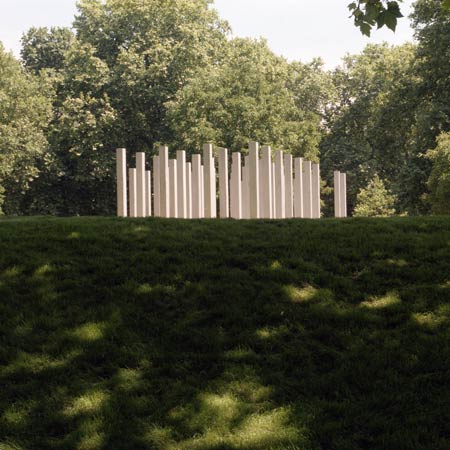
7 July Memorial by Carmody Groarke
A memorial to the victims of the 7 July terrorist bombings designed by architects Carmody Groarke has opened in London four years after the attacks.
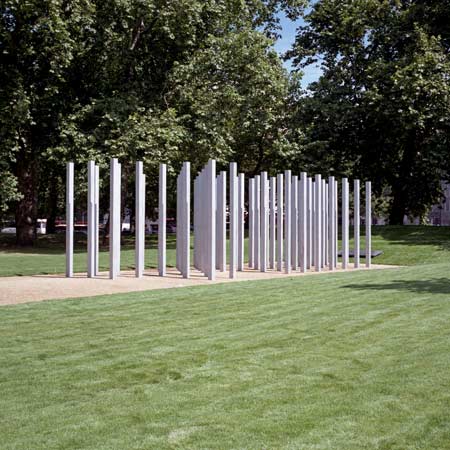
The memorial, in Hyde Park, consists of 52 cast stainless steel columns - one for each of the 52 people who lost their lives.
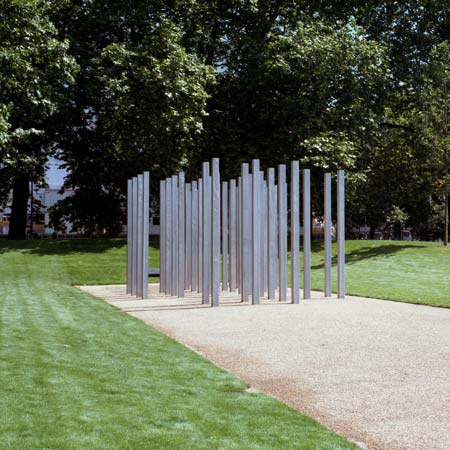
More info in our earlier story about the memorial.
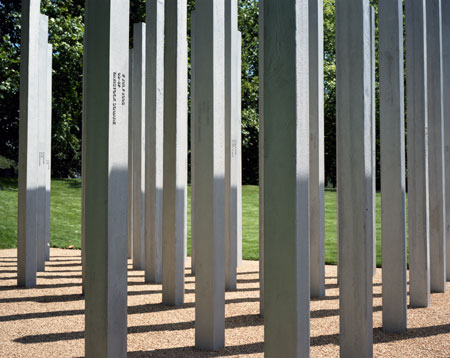
Here's some text from the architects:
--
7 July Memorial, Hyde Park, London
A permanent memorial to honour the victims of the 7 July 2005 London bombings, will be unveiled in Hyde Park by Their Royal Highnesses, The Prince of Wales and The Duchess of Cornwall, senior political figures and the families of the 52 killed, on the fourth anniversary of the disaster, Tuesday 7 July 2009. This unique civilian memorial marks the 52 lives lost in the four terrorist bombings in London in 2005. It will offer the opportunity for a sense of closure to the bereaved families as well as a public place of remembrance for all that were affected by the bombings.

The design of the memorial commemorates each life lost with singular columns (or stelae). Each of the 52 victims are represented together in four inter-linking clusters reflecting the four separate locations of the tragic incidents – Tavistock Square, Edgware Road, Kings Cross, and Aldgate. Constructed from solid-cast, long-lasting stainless steel, each stele measures 3.5 metres high and will be unique, with individual characteristic finishes brought about by the casting process. Through the choice of materials and the memorial’s robust nature, it has been designed to stand for many generations.

Visitors will be able to walk around and through the memorial, reading inscriptions marking the date, time and locations of the bombings placed on each of the stelae as they pass. A stainless steel plaque listing the names of the victims will be sited on a grass bank at the far eastern end of the memorial, itself included as a sensitive landscaping element to create an increased sense of quiet contemplation within this busy corner of the park.
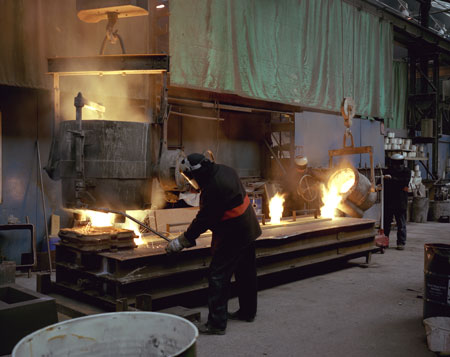
The project was commissioned by the Department for Culture, Media and Sport (DCMS) on behalf of the bereaved families. A Project Board was formed with representatives of the bereaved families, DCMS and The Royal Parks to find a suitable site and design for a memorial, agreed to be located in Hyde Park. A design team was selected and appointed on the basis of their design approach, following an open international competition process, and includes architects Carmody Groarke, engineering team Arup and landscape architects Colvin and Moggridge Ltd. Antony Gormley was consulted as artistic advisor to the Project Board at key stages in the design process. The design team collaborated with Phil Baines.

The team worked closely with representatives of the bereaved families to design a memorial with them. The first stage was to select a suitable site which, at the families’ request, was chosen as the South East corner Hyde Park, near Park Lane. The design then evolved through a process of collaboration and consultation, ensuring that the bereaved families’ feelings and needs were individually met whilst sensitively and powerfully representing their loved ones collectively in memorium.
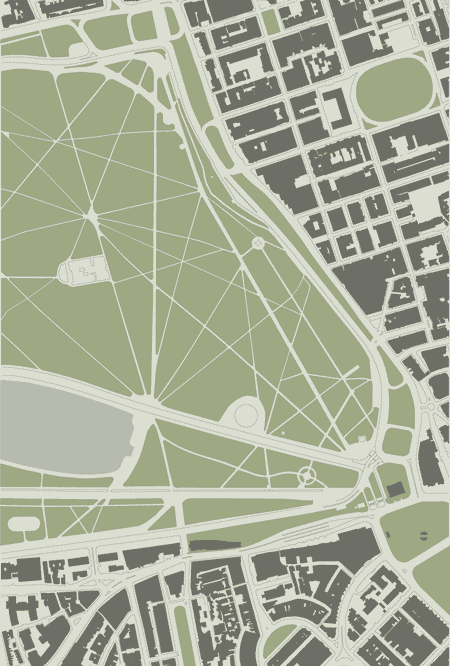
Planning Permission and English Heritage approval for final proposals within the Grade 1 Listed Royal Park were successfully achieved in July 2008 and the memorial has been subsequently delivered on time and on budget with the expertise of specialist stainless steel foundry Norton Castings Ltd.
A representative of the bereaved families group said: “This Memorial is a fitting tribute, honouring the 52 lives lost on 7 July 2005, ensuring that the world will never forget them. It represents the enormity of our loss, both on a personal and public level. We hope this Memorial will speak to visitors, so they can understand the impact of these horrific events.”
Architects Carmody Groarke, said: "We are proud to have been given the opportunity to help the bereaved families to create a fitting memorial to their loved ones. By working in close and constant consultation with them and the wider design team, we feel we have designed something that fulfils their brief to us: to create a memorial that allows for a collective experience as well as being a place of relative quiet for contemplation for the families and the wider public."
“We hope that the memorial successfully conveys both the singular and the collective loss in these tragic events to the bereaved families and to London.”
The project’s artistic advisor, Antony Gormley said: ‘This monument uses the language of architecture to create order out of chaos. It is an opportunity for a lost subject to be in contact with a perceiving subject in a process of discovery, where the structure of becomes completed by the presence and body language of the curious perceiver’.
Chris Carroll, engineer at Arup, commented: "Clearly this was a very emotional project for us all. But as a creative design team, I think we brought the right balance of sensitivity and professionalism to this brief. I believe we have created a thoughtful and lasting tribute to those who lost their lives in the 7 July bombings."
Carmody Groarke
Carmody Groarke is an award-winning, London-based architectural studio, established in 2006 by Kevin Carmody and Andrew Groarke. Recent projects include: the new headquarters for The Architecture Foundation, London; an underground swimming pool in Ireland; a major contemporary art exhibition design in The Natural History Museum entitled After Darwin: Contemporary Expressions; and a collaboration with Fondazione Prada for a temporary art installation with Carsten Holler entitled The Double Club. Current projects include a new build arts building for The Sheffield Festival Centre and an ornamental pavilion for developer British Land within their Regents Place masterplan next to Regents Park, London. In 2007 Carmody Groarke were proud recipients the prestigious UK Young Architect of the Year Award.
Arup
Arup is a global firm of designers, engineers, planners and business consultants providing a diverse range of professional services to clients around the world. Arup has over 10,000 staff working in more than 90 offices in 37 countries. At any one time, they have over 10,000 projects running concurrently.
Arup’s multi-disciplinary approach means that any given project may involve people from any or all of the sectors or regions in which they operate. Their fundamental aim is to bring together the best professionals in the world to meet clients' needs. Arup has a significant influence on the built environment and is the creative force behind many of the world’s most innovative and sustainable designs.
Foundry: Norton Cast Products
Norton Cast Products is a Sheffield based, independently owned steel castings foundry established in 1978. They are specialists in the production of engineering castings for several market sectors including manufacturing power, defence, minerals and mining.
Department of Culture Media and Sport
The Department of Culture Media and Sport (DCMS) are responsible for Government policy on the arts, sport, the National Lottery, tourism, libraries, museums and galleries, broadcasting, creative industries including film and the music industry, press freedom and regulation, licensing, gambling and the historic environment. We are the Department responsible for 2012 Olympic Games & Paralympic Games. The DCMS are also responsible for the listing of historic buildings and scheduling of ancient monuments, the export licensing of cultural goods, the management of the Government Art Collection and for the Royal Parks Agency. They have responsibility for humanitarian assistance in the event of a disaster such as the London bombings, as well as the organisation of the annual Remembrance Day Ceremony at the Cenotaph. In May 2005 DCMS broadened their existing links to the creative industries by taking over responsibility for fashion design, advertising and the arts market from the Department for Business, Enterprise and Regulatory Reform (BERR).
The Royal Parks
The Royal Parks are responsible for the management and conservation of several of the most important public parks in London including: Bushy Park (with the Longford River), The Green Park, Greenwich Park, Hyde Park, Kensington Gardens, The Regent's Park (and Primrose Hill), Richmond Park, St James's Park. They also tend a number of other spaces in London, including Brompton Cemetery, the gardens of 10, 11 and 12 Downing Street, and Grosvenor Square Gardens. The Royal Parks is an executive agency of the Department for Culture, Media and Sport (DCMS).
Antony Gormley – Artistic Advisor
Over the last 25 years Antony Gormley has revitalised the human image in sculpture through a radical investigation of the body as a place of memory and transformation, using his own body as subject, tool and material.
He was awarded the Turner Prize in 1994 and the South Bank Prize for Visual Art in 1999 and was made an Order of the British Empire (OBE) in 1997. In 2007 he was awarded the Bernhard Heiliger Award for Sculpture. He is an Honorary Fellow of the Royal Institute of British Architects, Trinity College, Cambridge and Jesus College, Cambridge, and has been a Royal Academician since 2003.
Professor Phil Baines
Phil Baines graduated from St Martin’s School of Art in 1985 and the Royal College of Art in 1987. He has worked as a freelance designer since that time and is known for type designs for Neville Brody’s Fuse project and Linotype; and editorial design for arts organisations and publishers such as Matt’s Gallery, London, Laurence King and Thames & Hudson. He has taught half full-time at Central Saint Martins since 1991 where he is now Professor of Typography. He is author of three books Type & typography, with Andrew Haslam, (Laurence King 2002), Signs, lettering in the environment, with Catherine Dixon (Laurence King 2002), and Penguin by design: a cover story 1935–2005, (Allen Lane 2005).
Colvin & Moggeridge
Colvin and Moggridge are chartered landscape architects with offices in Gloucestershire and London, undertaking commissions throughout the United Kingdom and Eire, and in continental Europeundertaking commissions throughout the United Kingdom and Eire, and in continental Europe. The practice was founded by Brenda Colvin in 1922. Originally an accomplished garden designer, Brenda Colvin was highly influential in the establishment of the profession of Landscape Architecture and was a founder member of the Landscape Institute.